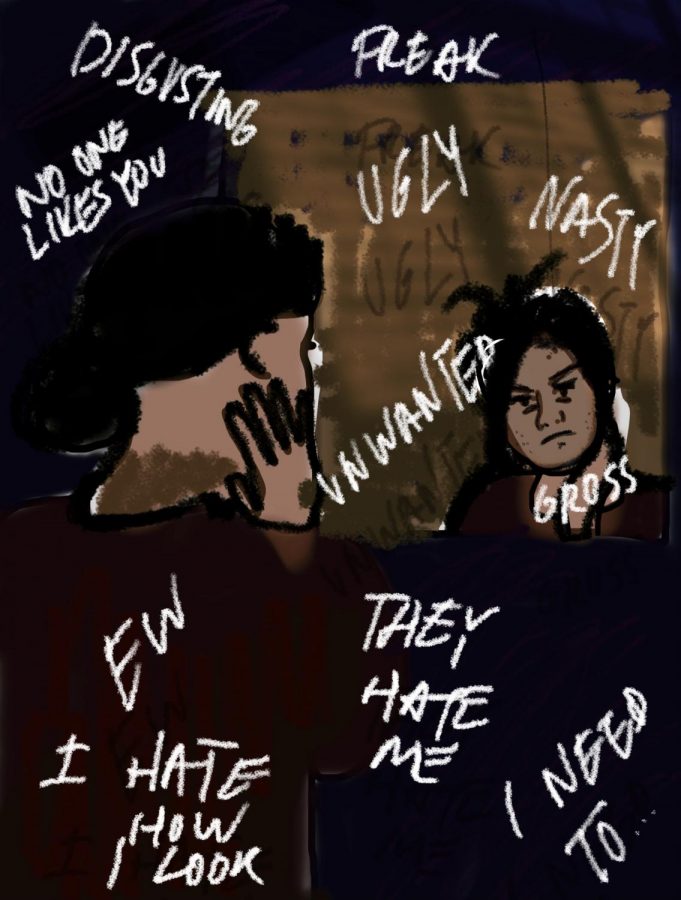Cultivating self worth within a toxic society
Illustration by Lila Portis
January 25, 2021
As a seventeen-year-old girl, I feel the toll of grasping for utter perfection from myself daily. It’s impossible to perfect a balance within the fine line we have drawn as a society between self-obsession and self-loathing. Growing up, my childhood was filled with shows that exhibited Barbie doll girls with the most seemingly perfect life. For many of us, we subconsciously associate beauty with success. While this ever-shifting culture is moving in the right direction, there are still immense ways in which the world must change, one of the most important being body positivity.
“[For me] body positivity is always maintaining a positive attitude towards what you see in the mirror,” sophomore Blythe Coleman explains. “[Body positivity] is showing your body love and nourishment, because in the end, your body is beautiful no matter what it looks like.”
Over time, the definition of body positivity has broadened, now being defined as something that is unique to each individual person. The way that one loves oneself cannot be expressed by a definition of words but rather by expressive actions of self-love. There is no scale for self-love, which makes loving one’s body unique on its own.
Looking at beauty standards through the decades shows that society magnifies on one major aspect of a woman’s body above all else: weight. Throughout history, there have been significant changes in beauty standards including hairstyles, heights, skin tones and, of course, weight. However, they all portray skinny women. According to CNNhealth, the only two time periods in which larger bodies were preferred were in Victorian England, where weight showed the equivalent to wealth, and in ancient Greece, where goddesses were portrayed with many curves. In today’s society, there is a great divide driven between people who believe slimmer is better and those who are choosing to celebrate all body types.
“I don’t think society is very inclusive to all body types. There are still constant beauty standards that change over time,” sophomore Sophie Glantz says. “Also, people that are often given the spotlight like celebrities or influencers usually look a certain way that does not represent what most people look like, which causes people to strive to look a certain way.”
Author Lew Louderback started the very first body movement by publishing an essay called “More People Should Be Fat”. In his writing, Louderback critiques the way that fat people are treated in America and explains the discrimination he sees against plus-sized people. Two years after Louderback’s piece was published, a New York engineer read the essay and was inspired to do something about the treatment of ‘overweight’ people in America. Feeling a personal connection to this issue, as his wife herself was considered overweight, Bill Fabrey created the National Association to Advance Fat Acceptance (NAAFA).
Discouraged by doctors labeling patients as overweight without biological evidence, the NAAFA promotes a healthy-at-every-size model where health is not measured by the number on a scale but rather through vital signs such as blood pressure, heart rate, cholesterol, diet and exercise.
Later on, in 1996, the organization “The Body Positive” was founded by Elizabeth Scott and Connie Sobczak. Mainstream, predominantly white movements like these shut out people of color and perpetuated the incorrect assumption that the Black community was more accepting of plus-sized people, and thus did not need body positivity activism. Black women rose up and expressed their love for their bodies, encouraging others to include all people of color when referencing body positivity. Currently, when looking at body positivity influencers, many races and colors are shown. According to Zenerations, Margaret K. Bass led many women of color in body positivity starting with her essay “On Being a Fat Black Girl in a Fat-Hating Culture”. After writing about her experiences growing up in the segregated south during the 1950s and 1960s, Bass influenced other women to speak about the discrimination they faced. In today’s movements, racial inclusiveness is certainly a highlight for many brands. Along with race, many brands are creating a welcoming environment for people of the LGTBQ+ community, proving that body positivity is a space for all.
“I used to think about [eating] a lot, and it took up a lot of my energy; now I look to food as an enjoyment. Same with my body. I look at it and think of all of the amazing things that it is capable of doing, because looking at it isn’t what matters,” junior Rose Goodman says. “Our bodies help us survive and experience things, and, without them, we couldn’t do those things. Viewing our bodies as less materialistic and more about what it helps you to do in life is really important.”
The greatest threat to acknowledging self-worth lays behind millions of pixels on a little screen; who knew something so little could hold so much power? In perspective, social media has turned into an alternate universe, presenting seemingly perfect lifestyles for each and every person. Social media platforms have changed purpose and perspective over the years, changing from a predominantly light hearted and humorous way to stay in touch to a picture perfect nightmare. Obviously, there is some appeal to the change—as it has not aged backwards—yet many still find social media to be a toxic environment.
“You only see the thing you love in other people and something that you don’t like in yourself. I think that people are opening up more about that and making it a really talked about thing,” senior Gabby Sloane says. “Instagram is everyone’s highlight reel… We need to stop comparing ourselves when we are at our lowest moments to people who are filtering their highest moments.”
Many social media accounts with slimmer women showing off their bodies are praised with comments like “I wish I looked like this” or “How do I make myself look like this??”
These comments are very problematic and drive women to think lowly of themselves. Additionally, there are people who “skinny shame” others with comments like “go eat food.” This can be very triggering for people that may suffer from an eating disorder or were just born with a high metabolism.
However, among this hostile environment, there is also a beautiful side of social media, where people are starting to show their healthy habits including guidance to self-love.
“I’ve started to see so many more positive accounts and posts on social media, and it really makes me hopeful for the way people will start to think about and love themselves,” junior Emma Boczkowski says. “I know that people think of social media as a hurtful place; I have definitely had my hardships with it, but now I think it’s changing.”
There is a large community of people—many of them women—that want to show their curves, rolls, cellulite, acne and live in a judgment-free society. This surge of self-love has created a community of people that want to change the perception of “the perfect body” on the way to becoming a more welcoming and encouraging society. Currently, many of the most well-known body positivity influencers are celebrities and have chosen to use their platform as a way to advocate for self-love. Just a few of these influencers that our current generation looks up to today include singer Lizzo, TikTok creator Sienne Gomez, model Ashley Graham and many more.
Although individuals of all ages and genders may struggle with body image and self-worth, teenage girls are more likely to face these issues. According to a survey from The Atlantic, “until the age of 12, there was virtually no difference in confidence between boys and girls. But, because of the drop-off girls experienced during puberty, by the age of 14, the average girl was far less confident than the average boy.”
“I most definitely feel way more pressure than the guys do,” Sloane says. ”Honestly, [objectifying women’s bodies] is how society was made; it’s always been that way. It’s a really big thing, focusing on how we can improve the body positivity movement and just change how people approach and talk about the subject, especially how the media treats and portrays women.”
Sloane’s feelings of being victimized by society and the media are not alone; many teenage girls feel that social media has affected their personal body image increasingly more than it does for males.
“The way that people pose and photoshop their bodies makes them seem flawless, and I wish that everyone just showed their natural bodies, because we are all beautiful,” Boczkowski says. “It’s really sad that we have such a set of beauty standards in society. In reality, when someone sees someone who is skinnier or has longer legs, they think that that is their ideal body, and they want to look like that.”
After listening to each one of these girls talk about their personal experiences, I realized that no girl is isolated in her own doubts of self-worth. I can feel hope filling the room with each significant self-love quote from these girls, and I have realized something that has changed my views: it is not the girls that need to change, but rather the society that wants to change the girls.



















